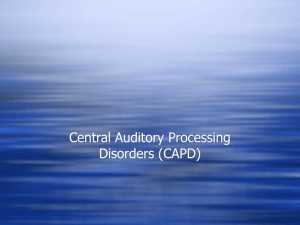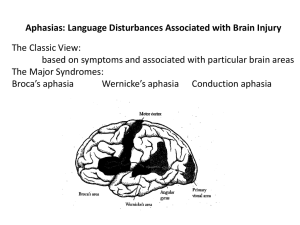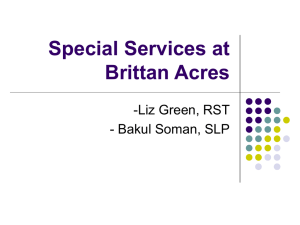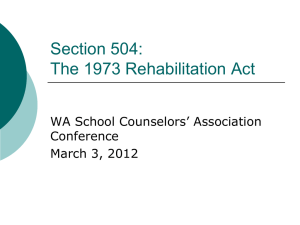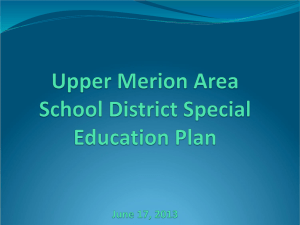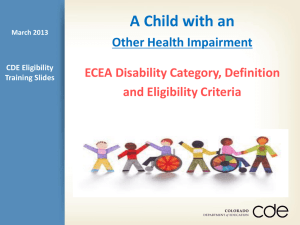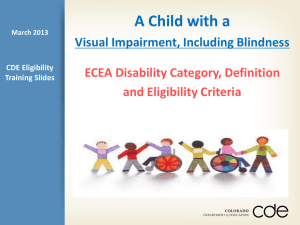Eligibility of a Child with Speech or Language Impairment
advertisement
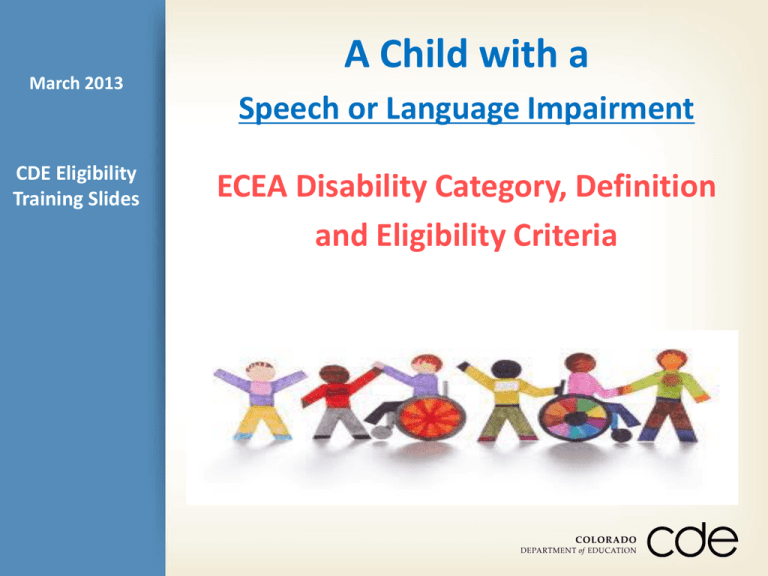
March 2013 CDE Eligibility Training Slides A Child with a Speech or Language Impairment ECEA Disability Category, Definition and Eligibility Criteria Together We Can Vision All students in Colorado will become educated and productive citizens capable of succeeding in a globally competitive workforce. Mission The mission of CDE is to shape, support, and safeguard a statewide education system that prepares all students for success in a globally competitive world. 2 Speech or Language Impairment The following slides have been vetted internally within the Colorado Department of Education for training purposes of the definition and eligibility criteria for Speech or Language Impairment. If you make any changes to these slides, please acknowledge that they are different from this vetted product and may no longer represent the viewpoint of the CDE. 3 Eligibility Checklist for Speech or Language Impairment It is recommended that the following training slides be used in conjunction with the post-HB11-1277 Eligibility Checklist for a Child with Speech or Language Impairment, which can be found at: http://www.cde.state.co.us/cdesped/IEP_Forms.asp 4 SPEECH OR LANGUAGE IMPAIRMENT Speech or Language Impairment Tami Cassel cassel _t@cde.state.co.us (303) 866-6114 This eligibility category does not have changes other than an alignment of new terminology and format. 5 2.08 (9) A child with a Speech or Language Impairment shall have a communicative disorder which prevents the child from receiving reasonable educational benefit from general education. 2.08 (9) (a) Speech or Language Impairment may be classified under the headings of articulation, fluency, voice, functional communication or delayed language development and shall mean a dysfunction in one or more of the following: 2.08 (9) (a) (i) Receptive and expressive language (oral and written) difficulties, including syntax (word order, word form, developmental level), semantics (vocabulary, concepts and word finding), and pragmatics (purposes and uses of language); 6 2.08 (9) (a) (ii) Auditory processing, including sensation (acuity), perception (discrimination, sequencing, analysis and synthesis), association and auditory attention; 2.08 (9) (a) (iii) Deficiency of structure and function of oral peripheral mechanism; 2.08 (9) (a) (iv) Articulation including substitutions, omissions, distortions or additions of sound; 2.08 (9) (a) (v) Voice, including deviation of respiration, phonation (pitch, intensity, quality), and/or resonance; 2.08 (9) (a) (vi) Fluency, including hesitant speech, stuttering, cluttering and related disorders; and/or 2.08 (9) (a) (vii) Problems in auditory perception such as discrimination and memory. 7 2.08 (9) (b) The Speech or Language Impairment, as set out above, prevents the child from receiving reasonable educational benefit from general education and shall include one or more of the following: 2.08 (9) (b) (i) Interference with oral and/or written communication in academic and social interactions in his/her primary language; 2.08 (9) (b) (ii) Demonstration of undesirable or inappropriate behavior as a result of limited communication skills; and/or 2.08 (9) (b) (iii) The inability to communicate without the use of assistive, augmentative/alternative communication devices or systems. 8 To Be Eligible as a Child with a Speech or Language Impairment Classified as articulation, fluency, voice, functional communication, or delayed language development Evidence of dysfunction in one or more of the following areas: Receptive/Expressive Language, Auditory Processing, Oral peripheral structure, Articulation, Voice, Fluency and/or Auditory Perception 9 K-12 SLI Guidelines Including Birth-21 Rating Scale Developed by Colorado school Speech-Language Pathologists. Provides guidance in determining severity of speech or language impairment. Allows for use of normative assessment data as well as observational data in determining educational disability/ Provides rubric for all speech or language areas. Considers impact of speech or language impairment to educational performance 10 Primary Language Considerations Social, cultural and linguistic diversity for students whose language is something other than English. Impact in areas of speech development, pragmatics, and language development. Collaborate with English Language Acquisition (ELA) staff to determine a disability versus a difference. . 11 Family Involvement Interview family for input regarding speech or language development concerns Family input is critical for students who are learning English as a second language Family involvement is necessary for all Eligibility Meetings 12 Dual Language Learners Learn social language quicker than academic language Up to 7 years to learn social language (BICS) 7+ years to learn academic language (CALP) May experience a silent period not to be confused with Selective Mutism Delay must be present in both languages 13 Receptive and Expressive Language Syntax - sequencing words to formulate grammatically correct sentences in verbal or written language. Use of morphological structures such as plurals, possessives, verb tense Semantics – Vocabulary comprehension and use, word retrieval, concept development Pragmatics – Social language Use involves Using language for different purposes, Changing language for different listeners, Following conversational rules 14 Receptive and Expressive Language Consideration must be given to the student’s receptive and expressive language skills in his or her primary language Difficulties must be present in oral and/or written language Language development should be compared to same- aged peers of like social, cultural and linguistic backgrounds Auditory Processing How the brain interprets what it hears Auditory processing problems may also be known as a Central Auditory Processing Disorder (CAPD) CAPD is NOT due to a higher order cognitive-communicative or language-related dysfunction. It includes Sensation (Acuity), Perception (discrimination, sequencing, analysis and synthesis of sounds and words), Association and Auditory Attention Collaboration with Audiologists regarding assessments for CAPD such as Dichotic speech tests and Auditory Discrimination tests Consultation with Audiologists for identification 16 Deficiency of Structure and Function of Oral Peripheral Mechanism Oral structure anomalies such as cleft palate, macroglossia (tongue is large relative to the oral cavity) Oral motor difficulties which interfere with speech such as Apraxia Nasal cavity anomalies such as deviated septum Some structural anomalies may not interfere with speech production such as Macrostomia (one corner of mouth extends into cheek) Structural or functional anomaly must have an educational impact 17 Articulation Substitutions - replacing one sound for another such as “kitten” becomes “titten” Omissions – deleting a sound from a word such as “spider” becomes “pider” Distortions – atypical production of a sound not commonly heard in the primary language such as the lateral /s/ Additions of a sound – another sound is added to a word such as “breakfast” becomes “breakflast” 18 Developmental vs. Delay Speech skills develop in a predictable pattern Some misarticulations are considered developmental for the student’s age ( i.e. a 3 year old who says “wabbit” for “rabbit”) Dual Language Learners (English as a second language or simultaneous with a native language) may not develop at the same rate or pattern. Consult with ELA staff Culture and dialect within the United States must be considered 19 Voice Disorders in respiration, such as speaking on inhalation Phonation which includes pitch, intensity, quality Resonance - nasal quality to voice (hyponasal or hypernasal) Must have an educational impact 20 Fluency Stuttering - speech production which is characterized by sound or word repetitions, blocking on a word, or prolonging a word or sound of a word Cluttering - speech delivery rate which is either abnormally fast or irregular or both Hesitant Speech - interruptions of the flow of speech 21 Auditory Perception Ability to discriminate sound production Ability to remember the sequence of sounds which form words Positive correlation to reading development Must have an educational impact 22 (SLI): The Child Cannot Receive REB from General Education Prevents the child from receiving reasonable educational benefit from general education AND includes one or more of the following: Interference with oral and/or written communication in academic and social interactions in his/her primary language; Demonstration of undesirable or inappropriate behavior as a result of limited communication skills; The inability to communicate without the use of assistive, augmentative/alternative communication devices or systems. 23 Specially Designed Instruction “Specially Designed Instruction" means adapting, as appropriate to the needs of an eligible child, the content, methodology or delivery of instruction to address the child's unique needs resulting from the disability and ensuring the child's access to the general curriculum so that he or she can meet the educational standards that apply to all children within jurisdiction of the public agency. 34 CFR 300.39 (b)(3). It involves providing instruction that is different from that provided to children without disabilities, based upon the eligible child’s unique needs. 24 Behavior Related to Limited Communication Skills Nonverbal students use behavior as a way of communicating Differential Diagnosis to rule out another disability 25 AAC Devices or Systems Assistive Alternative Augmentative Communication devices or systems (AAC) Any item that assists a student with a disability in accessing education Ranges from simple low technology like a picture schedule to sophisticated high technology electronic devices SWAAAC teams can evaluate and assist with procuring devices State loan bank for trial with Assistive Technology or AAC devices 26 To be Eligible as SLI, the Child Must Meet All Three Conditions 1. Must have an identified communicative disorder. 2. Educational performance must be adversely impacted by the communicative disorder. 3. Must require specially designed instruction for educational benefit 27 Thank You! 28


